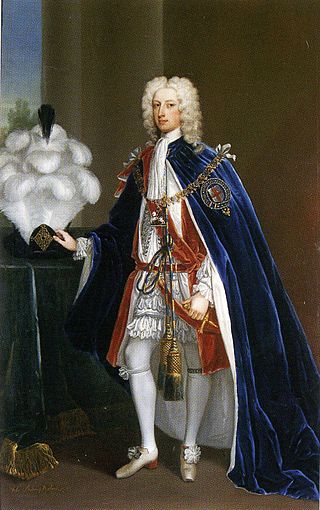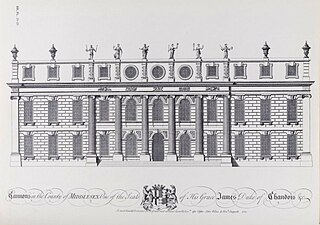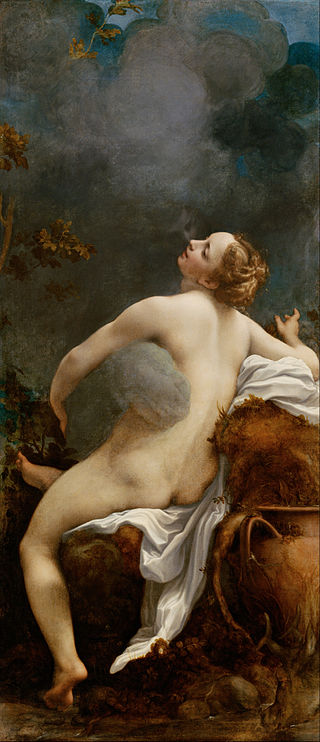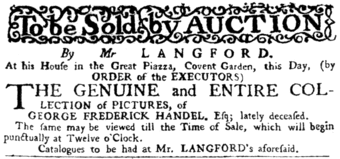
William Thomas Beckford was an English novelist, art critic, planter and politician. He was reputed at one stage to be England's richest commoner.

John Manners, 3rd Duke of Rutland KG PC was an English nobleman, the eldest son of John Manners, 2nd Duke of Rutland and Catherine Russell. Styled Marquess of Granby from 1711, he succeeded to the title in 1721, cutting short a brief career in the House of Commons, where he had represented Rutland as a Whig.

Louis-François Roubiliac was a French sculptor who worked in England. One of the four most prominent sculptors in London working in the rococo style, he was described by Margaret Whinney as "probably the most accomplished sculptor ever to work in England".
Pierre Crozat (1665–1740) was a French financier, art patron and collector at the center of a broad circle of cognoscenti; he was the brother of Antoine Crozat.

Judith Beheading Holofernes is a painting of the biblical episode by Caravaggio, painted in c. 1598–1599 or 1602, in which the widow Judith stayed with the Assyrian general Holofernes in his tent after a banquet then decapitated him after he passed out drunk. The painting was rediscovered in 1950 and is part of the collection of the Galleria Nazionale d'Arte Antica in Rome. The exhibition 'Dentro Caravaggio' Palazzo Reale, Milan, suggests a date of 1602 on account of the use of light underlying sketches not seen in Caravaggio's early work but characteristic of his later works. The exhibition catalogue also cites biographer artist Giovanni Baglione's account that the work was commissioned by Genoa banker Ottavio Costa.

An art auction or fine art auction is the sale of art works, in most cases in an auction house.

Pierre-Jean Mariette was a collector of and dealer in old master prints, a renowned connoisseur, especially of prints and drawings, and a chronicler of the careers of French Italian and Flemish artists. He was born and died in Paris, and was a central figure in the artistic culture of the city for decades.

Frederik Johannes "Frits" Lugt, was a self-taught collector and connoisseur of Dutch drawings and prints and a selfless and tireless compiler of essential reference tools documenting Northern European prints and drawings, collectors' stamps and sale catalogues. An authority on Rembrandt's drawings, he collected all of the known etchings made by Rembrandt during his career.

Water Lilies is a series of approximately 250 oil paintings by French Impressionist Claude Monet (1840–1926). The paintings depict his flower garden at his home in Giverny, and were the main focus of his artistic production during the last thirty years of his life. Many of the works were painted while Monet suffered from cataracts.

Cannons was a stately home in Little Stanmore, Middlesex, England. It was built by James Brydges, 1st Duke of Chandos, between 1713 and 1724 at a cost of £200,000, replacing an earlier house on the site. Chandos' house was razed in 1747 and its contents dispersed.

The Orleans Collection was a very important collection of over 500 paintings formed by Philippe II, Duke of Orléans, mostly acquired between about 1700 and his death in 1723. Apart from the great royal-become-national collections of Europe it is arguably the greatest private collection of Western art, especially Italian, ever assembled, and probably the most famous, helped by the fact that most of the collection has been accessible to the public since it was formed, whether in Paris, or subsequently in London, Edinburgh and elsewhere.

Philippe Mercier was an artist of French Huguenot descent from the German realm of Brandenburg-Prussia, usually defined to French school. Active in England for most of his working life, Mercier is considered one of the first practitioners of the Rococo style, and is credited with influencing a new generation of 18th-century English artists.

Abraham Langford (1711–1774) was an English auctioneer and playwright.

Thomas Worlidge (1700−1766) was an English painter and etcher.
Jacob Abrahamsz. Dissius was a Dutch typographer and printer. He inherited a collection of 21 of Johannes Vermeer's works, including The Milkmaid, Portrait of a Young Woman, A Girl Asleep, Woman Holding a Balance, and The Music Lesson. In 1680, he married Magdalena, daughter and sole heir of Vermeer's main patron Maria de Knuijt, her mother, with her father Pieter van Ruijven. Dissius died in 1695, and his collection was auctioned off in Amsterdam the following year.

Lincoln in Dalivision is a 1977 original limited edition lithograph created by Salvador Dalí. It is often considered one of the most counterfeited Dalí lithographs. Dalí authentication experts who have noted the counterfeiting issue with this work include Albert Field, Frank Hunter, Robert Descharnes and Bernard Ewell. Lee Catterall comments in his book The Great Dalí Art Fraud & other deceptions, "The painting most commonly reproduced for such fraudulent purposes was Lincoln in Dalivision, 'prints' of which Los Angeles art appraiser Dena Hall testified in the Hawaii trial have become as commonplace as 'pancakes at the pancake house.'"
William Meriton Eaton, 2nd Baron Cheylesmore is best remembered as a leading collector of English mezzotint portraits, and collector of other art. His mezzotints and other prints, over 10,000 in number, were left to the British Museum, and five oil paintings to the National Gallery, London. He also stood unsuccessfully for Parliament for the Conservative Party at Macclesfield in 1868, 1874 and 1880, and held a nominal partnership in the family silk business.
John Blackwood was a Scottish merchant who early in his life was a slave trader in New Spain and a politician who sat in the House of Commons briefly from 1727 to 1728. Later he became a noted and sought-after art dealer. He was based in London but travelled widely on the Continent, and was one of the first dealers to introduce the works of Murillo to Britain.
Christopher Cock was an eminent English auctioneer and picture restorer who lived and worked in London. His earliest known auction was in 1717. He operated from various premises in Soho until 1731, when he moved to the Great Piazza, Covent Garden. Cock was auctioneer of the properties and possessions of many well-known men of the time. He was married to Ann, but nothing more is known of his wife or any children; Cock died in 1748 and is buried at St Paul's, Covent Garden.
Selwyn Peter Webb was a New Zealand art dealer and gallery director. He was a supporter and promoter of art, and particularly contemporary New Zealand art, for over sixty years. Webb's work spanned public art museums, publishing and the founding of the Peter Webb Galleries and Webb's auction house.














